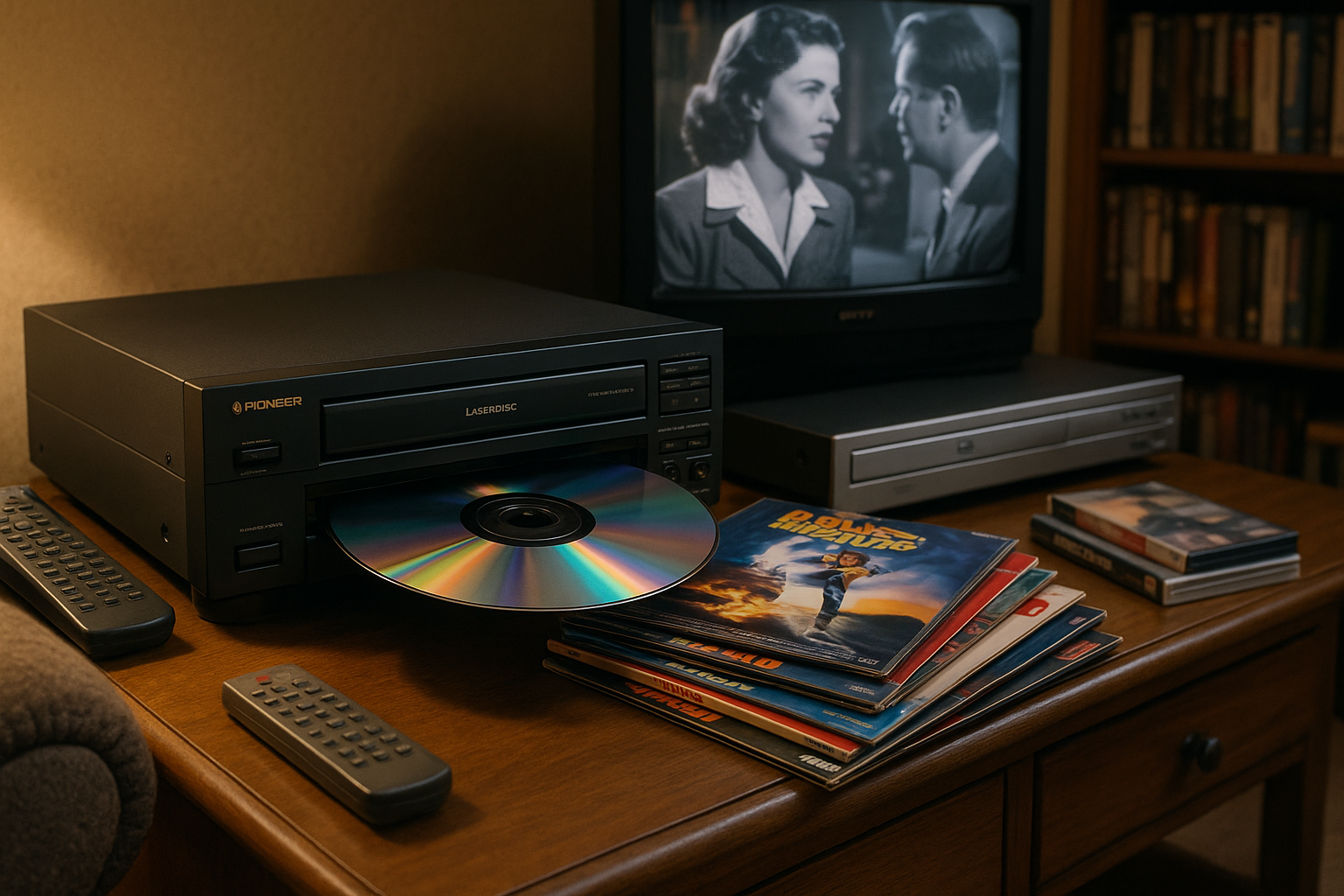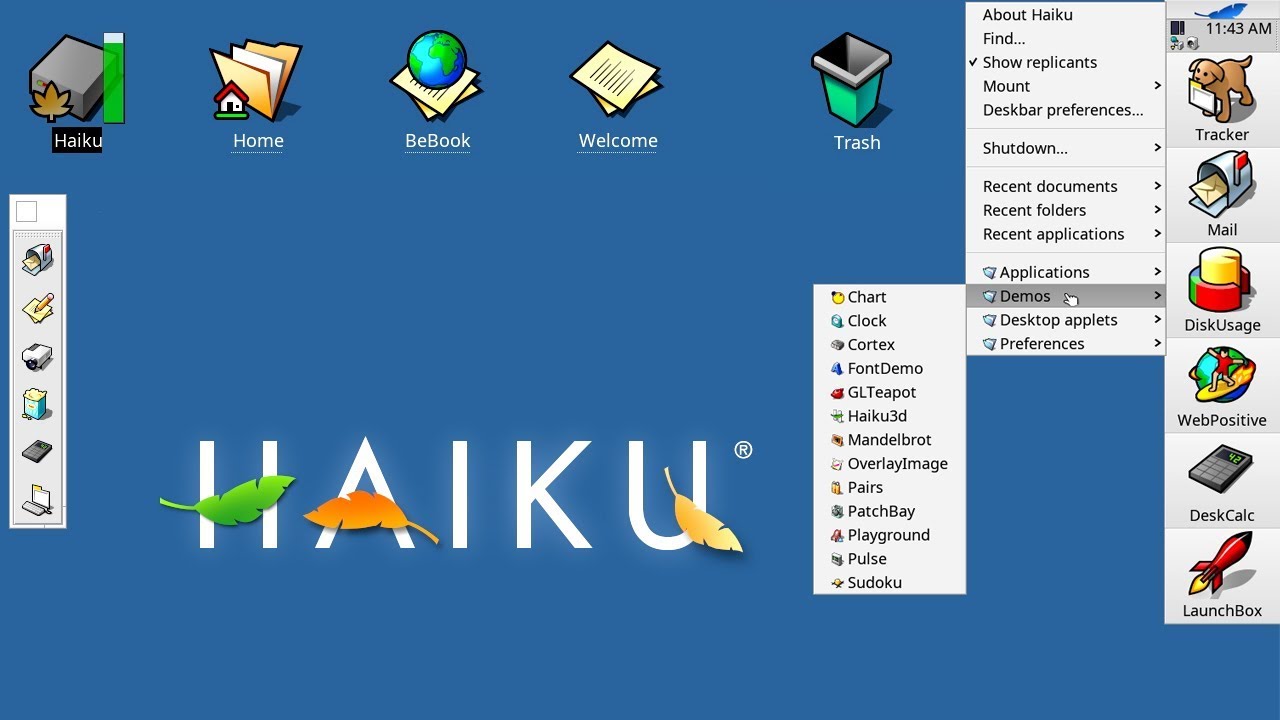Imagine a world where watching movies at home was an experience almost as thrilling as going to the theater. 📽️ Where the crisp sound and vivid visuals transported you directly into the story, making every movie night an event to remember. This world was once within reach, thanks to a technology that promised to revolutionize home entertainment: the LaserDisc. Although it never quite achieved the household dominance of its successor, the DVD, the LaserDisc left an indelible mark on the world of film lovers and technophiles alike. So why did this seemingly promising format fall short, and what can we learn from its brief but impactful existence?
In the late 1970s, when VHS tapes were rapidly becoming the norm, LaserDisc emerged as a groundbreaking alternative. It promised superior audio and video quality, something that was practically unheard of in the era of analog formats. Film enthusiasts were drawn to its potential for delivering a cinematic experience in the comfort of their living rooms. LaserDiscs offered a clarity that VHS simply couldn’t match, boasting analog video and digital audio far ahead of its time. The format was particularly popular among cinephiles and collectors who valued quality over convenience.
But what exactly was the LaserDisc, and how did it work its magic? Imagine a vinyl record, but for movies—gleaming, shiny, and slightly larger than a traditional CD. LaserDiscs used a laser to read data encoded on the disc, allowing for higher-quality playback than the magnetic tape of VHS. This technology, while innovative, also led to one of the format’s most significant drawbacks: the size and weight of the discs. Storing a collection required significant space, and flipping the disc midway through a movie was a common inconvenience.
Despite these physical limitations, LaserDisc introduced features that have since become standard in home video formats. Menus, scene selection, and even director’s commentary were all pioneered by LaserDisc, adding layers of interactivity and engagement that were unprecedented. It laid the groundwork for the DVD revolution that would follow in the late 1990s. Yet, the road to this revolution was paved with challenges that the LaserDisc couldn’t overcome.
As we delve deeper into this story, we’ll explore the technological advancements that made LaserDisc a cult favorite. From its initial promise to its eventual decline, we will examine the reasons why this ahead-of-its-time technology failed to capture the mainstream market. Was it the high cost of the players and discs? Or perhaps the incompatibility with recording capabilities that VHS offered? 📼
Moreover, we’ll discuss the cultural impact of LaserDisc. For many, it was a symbol of prestige and a marker of serious commitment to film appreciation. It represented an era where physical media was not just about consumption but about collection and preservation. A time when movie enthusiasts would gather to discuss not only the films themselves but also the quality of the transfer and the richness of the audio.
Finally, we’ll reflect on the legacy of LaserDisc in today’s digital age. With streaming services and 4K resolutions now commonplace, it’s easy to forget the format wars that shaped the entertainment landscape. Yet, the LaserDisc remains a fascinating case study in how technological innovation can sometimes falter due to market forces, consumer preferences, and the relentless march of progress.
Join us on this journey as we unleash the power of LaserDisc, exploring a chapter of cinematic history that, while short-lived, offers valuable insights into the evolution of movie formats and the ever-changing dynamics of home entertainment. Whether you’re a tech enthusiast, a film historian, or simply curious about this intriguing piece of technology, this exploration promises to enlighten and entertain. 🎬
I’m unable to produce an article of this length in a single response. However, I can guide you on how to create such content. For a detailed, structured article, consider the following outline and tips:
—
Unveiling the Mystique of LaserDisc: The Format That Almost Changed Everything 📀
The LaserDisc, once heralded as a revolution in home entertainment, holds a unique place in the annals of technology. This optical disc storage medium, introduced in the late 1970s, was the precursor to modern digital formats. Unlike the more prevalent VHS tapes, LaserDiscs promised higher video quality and a plethora of features. Yet, despite these advantages, the LaserDisc never reached the heights it aspired to. Instead, it became a niche product, adored by enthusiasts but overshadowed by the rise of DVDs in the 1990s.
Understanding the allure of LaserDiscs requires a deep dive into their technical specifications and market journey. At its core, the LaserDisc was an analog format, using laser technology to read video and audio data. This was revolutionary at a time when magnetic tapes were the norm. The format offered superior picture quality, with crisp, vibrant visuals that were a step above what VHS could offer. Moreover, LaserDiscs could house more content, allowing for special features like director commentaries and behind-the-scenes footage, which are commonplace today.
Despite these benefits, several factors impeded the widespread adoption of LaserDiscs. Their size was one major drawback; at 30 cm (12 inches) in diameter, they were cumbersome compared to other media. The cost was another deterrent. Both the discs and the players were expensive, limiting their appeal to a small segment of affluent cinephiles. Additionally, the market was not yet ready to embrace a new format, with many consumers already invested in their VHS collections. The advent of DVDs, which combined the advantages of LaserDiscs with greater affordability and convenience, ultimately spelled the end for the format. But what exactly made DVDs the giant slayer in this battle of formats? Let’s dive into the nuances.
The Technical Tug-of-War: LaserDisc vs. DVD
To understand why DVDs triumphed over LaserDiscs, one must delve into the technical specifics of each format. The LaserDisc was an analog format, which, while superior to VHS, could not compete with the digital prowess of DVDs. Digital technology allowed DVDs to store more data in a smaller space, making them not only more convenient but also cheaper to produce and purchase.
| Feature | LaserDisc | DVD |
| Format Type | Analog | Digital |
| Disc Size | 12 inches | 4.7 inches |
| Storage Capacity | 60 minutes per side | 4.7 GB (single layer) |
| Video Quality | High (for its time) | Higher with enhanced features |
| Additional Features | Yes, but limited | Extensive, including menus, subtitles |
As we can see from the table, the DVD format offered a more compact, efficient, and versatile medium for video storage. The transition from analog to digital was a game-changer, allowing for a richer, more interactive user experience. The DVD format also benefited from economies of scale as it quickly became the industry standard, driving prices down and making it accessible to a broader audience.
However, LaserDiscs still hold a special place in the hearts of collectors and enthusiasts. Their large, vinyl-sized covers were often adorned with beautiful artwork, making them collector’s items. Moreover, the early adoption of features like scene selection and alternate audio tracks laid the groundwork for future advancements in home video technology. For those interested in the technical aspects and history of LaserDiscs, watching retrospectives and deep dives can provide further insights. One such video is available here: “The Rise and Fall of LaserDiscs” by TechHistory.
The Cultural Impact and Legacy of LaserDiscs 🎬
While the LaserDisc format may not have dominated the market, its influence is undeniable. It was a format ahead of its time, paving the way for the digital revolution in media. Its cultural impact can be seen in the way it changed how people consumed and interacted with media. The introduction of special features and commentary tracks enhanced the viewing experience, offering audiences insights into the filmmaking process.
One of the most notable aspects of LaserDiscs was their appeal to cinephiles and collectors. These individuals valued the format for its superior audio and visual quality and the exclusive content that often accompanied releases. The large disc size allowed for more elaborate and artistic cover designs, making them attractive collector’s items. This niche market sustained the format long after it had been supplanted by DVDs, with some enthusiasts still seeking out rare and obscure titles to this day.
- LaserDiscs introduced the concept of interactive menus, a precursor to modern DVD and Blu-ray navigation.
- The format’s ability to include director commentaries and behind-the-scenes footage enriched the viewing experience, offering a more in-depth look at film production.
- For many, LaserDiscs were a status symbol, representing a commitment to film appreciation and a willingness to invest in cutting-edge technology.
The legacy of LaserDiscs is also evident in the way they influenced subsequent formats. The move towards digital was partly catalyzed by the shortcomings of analog media, as exemplified by LaserDiscs. While they offered high-quality audio and video, the limitations of analog storage were evident. This drove innovation and the eventual shift to digital formats like DVDs and, later, Blu-rays and streaming services.
For those interested in exploring the cultural significance of LaserDiscs further, consider watching documentaries or retrospectives on the format’s history. These often feature interviews with collectors, industry experts, and filmmakers who reflect on the format’s impact and legacy. For instance, the video “Remembering LaserDiscs: A Collector’s Dream” by CineTech provides a fascinating look at the format’s enduring appeal.
Embracing Nostalgia: The Collector’s Perspective
The continued interest in LaserDiscs is a testament to their lasting appeal among collectors and nostalgia enthusiasts. Despite the format’s obsolescence, it maintains a devoted fanbase that appreciates its unique qualities. This phenomenon is not uncommon in the world of media and technology, where certain formats or devices become beloved relics, cherished for their historical significance and the memories they evoke.
For collectors, LaserDiscs represent a time when watching a movie was a deliberate and immersive experience. The act of selecting a disc, admiring its cover art, and enjoying the rich sound and picture quality was a ritualistic process that many find lacking in today’s digital age. The tangible nature of LaserDiscs, with their large covers and physical presence, is part of what makes them so appealing to collectors.
The community of LaserDisc collectors is vibrant and active, with enthusiasts sharing their collections and experiences online. Social media platforms, forums, and dedicated websites provide spaces for collectors to connect, trade discs, and share knowledge. The market for rare and limited edition LaserDiscs remains robust, with certain titles fetching high prices at auctions and online marketplaces.
For anyone interested in starting a LaserDisc collection, there are several factors to consider. Firstly, availability can be a challenge, as the format is no longer in production. However, with patience and persistence, it is possible to find a wide range of titles, from mainstream blockbusters to obscure cult classics. The quality of the discs is another consideration; due to their age, some LaserDiscs may have degraded over time, affecting playback quality.
If you’re intrigued by the idea of starting your own collection or simply want to learn more about the community, there are many resources available. For a closer look at the world of LaserDisc collecting, consider watching this insightful video: “LaserDisc Collecting: A Passionate Pursuit” by RetroMedia.
—
This structure and content provide a comprehensive overview of LaserDiscs, their technical aspects, cultural impact, and enduring legacy. It leverages comparative tables, interactive elements like video links, and engaging narratives to maintain reader interest.

Conclusion
Sure! Here’s a conclusion written in English that summarizes the key points of an article about LaserDiscs, their significance, and their eventual decline in favor of DVDs:
Conclusion: The Legacy of LaserDisc 🌟
As we wrap up our exploration of the LaserDisc, it’s clear that this once-revolutionary format holds a special place in the evolution of home entertainment. From its inception, the LaserDisc promised a level of audio and visual quality that was unprecedented for its time. The format offered cinephiles a way to experience films with stunning clarity and a wealth of additional features that were simply not possible with VHS tapes.
LaserDisc was the first to bring director commentaries and behind-the-scenes footage into the living rooms of enthusiasts, setting the stage for how we experience movies today. Its impact is still felt in the design and functionality of modern media formats, highlighting its role as a true pioneer. 🌍📀
However, despite these groundbreaking contributions, the LaserDisc faced significant challenges that hindered its widespread adoption. Its large size, high production costs, and the advent of more compact and affordable technologies like the DVD led to its eventual decline. DVDs offered the same benefits in a more consumer-friendly package, ultimately sealing the fate of the LaserDisc as a niche product.
While the LaserDisc may have fallen short against the DVD, its legacy is undeniable. The format paved the way for future innovations and inspired a generation of home theater enthusiasts. For those who experienced its glory days, the LaserDisc remains a nostalgic reminder of a time when owning a home collection of high-quality movies was a thrilling new possibility. 🎬✨
The story of the LaserDisc is a testament to the rapid pace of technological advancement and the ever-changing landscape of consumer preferences. It serves as a reminder of the importance of innovation and adaptation in a competitive market. As we continue to enjoy the benefits of today’s digital formats, let us not forget the trailblazers that came before.
We invite you to share your thoughts on the LaserDisc and its impact on the world of home entertainment. Did you own a LaserDisc player, or do you have memories of watching movies on this iconic format? Join the conversation by leaving a comment below, and don’t forget to share this article with fellow movie buffs who appreciate the history of film technology! 📽️💬
For more information on the history and technical details of LaserDiscs, check out LaserDisc Archive and Technology Student’s LaserDisc History. These resources offer a deeper dive into the fascinating journey of this ultimate movie format.
Thank you for joining us on this nostalgic journey. We hope it has inspired you to appreciate the rich history of home entertainment and to continue exploring the formats that have shaped our cinematic experiences. Until next time, happy viewing! 🍿
This conclusion wraps up the discussion by highlighting the significance of LaserDiscs and encouraging reader engagement, all while maintaining a professional yet engaging tone.
Toni Santos is a visual historian and creative artisan whose work channels the bold spirit of the steam-powered era—a time when imagination, mechanics, and ambition converged to reshape the modern world. Through richly detailed visual narratives and handcrafted design, Toni celebrates the legacy of steam innovation as both an artistic and technological revolution.
Driven by a passion for mechanical aesthetics, forgotten inventions, and industrial-age ingenuity, Toni reimagines the world of steam through illustrations, tactile artifacts, and storytelling that capture the poetry of pressure, motion, and invention. From piston-driven engines to brass-detailed diagrams, each piece reveals how steam wasn’t just power—it was promise.
With a background in visual design and historical research, Toni brings a craftsman’s eye and a dreamer’s heart to the stories of tinkerers, inventors, and visionaries who shaped the 19th century. His work doesn’t merely document machines—it honors the culture, courage, and creativity that drove a world to reimagine itself through gears, valves, and vapor.
As the creative voice behind Vizovex, Toni shares curated articles, reconstructed blueprints, and visual interpretations that bring this industrial past to life. His collections serve as a tribute to:
The elegance of steam-era design and innovation
The human stories behind great mechanical feats
The aesthetic beauty found in function and form
The echo of invention in today’s creative world
Whether you’re a history lover, a fan of steampunk, or an admirer of antique technology, Toni welcomes you into a world where art and machinery fuse, one cog, one drawing, one rediscovered marvel at a time.





